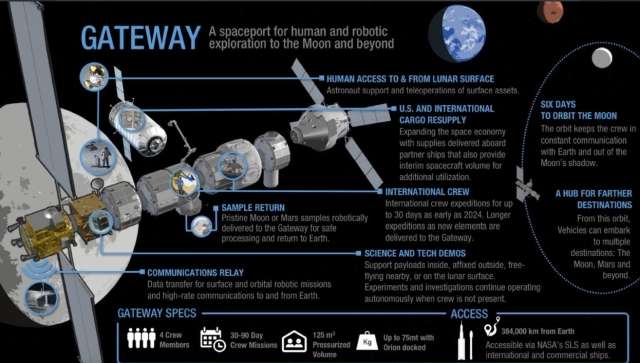"This isn't your grandfather's lunar lander.
Today (Oct. 3), aerospace giant Lockheed Martin revealed its concept for a reusable, single-stage spaceship capable of ferrying four astronauts between lunar orbit and the surface of the moon.
For comparison, the expendable lunar lander that NASA used during the Apollo program carried two people and weighed 4.7 tons (4.3 metric tons) without propellant. Lockheed's craft would weigh 24 tons (22 metric tons) dry and tip the scales at 68 tons (62 metric tons) when fully fueled. [Lunar Legacy: 45 Apollo Moon Mission Photos]
The Lockheed lander would use as its home base the Lunar Orbital Platform-Gateway, a small space station that NASA aims to start building near the moon in 2022.
The lander would depart from the Gateway, taking astronauts and up to 1.1 tons (1 metric tons) of cargo down to the lunar surface, according to a newly published Lockheed white paper. The craft (and crew) could stay on the surface for up to two weeks, then launch back to the Gateway without the need to refuel. (The lander would be refueled between missions — eventually, perhaps, with propellant derived from water ice extracted from the moon or asteroids.)
The lander design leverages many technologies from the Orion capsule, which Lockheed is building for NASA. Orion and the Space Launch System (SLS) megarocket, which is also in development, will help astronauts explore deep-space destinations, such as the moon and Mars, NASA officials have said.
"There's a lot of development that we've accomplished on Orion, so that helps," Tim Cichan, space exploration architect at Lockheed Martin Space, told Space.com. (Cichan presented the lunar-lander concept today at the International Astronautical Congress in Bremen, Germany.)
Orion already has one flight under its belt, an uncrewed test mission to Earth orbit in December 2014. NASA intends to fly the capsule again in 2020, on an uncrewed flight called Exploration Mission 1 that will also serve as the SLS' debut. (The 2014 Orion flight employed a United Launch Alliance Delta IV Heavy rocket.) On EM-1, Orion will loop around the moon and spend about three weeks in space. The first crewed Orion-SLS flight, Exploration Mission 2, is currently targeted for 2023."
And here's the craft:

Fully reusable, so unlike in the Apollo program the lander would go up and down in one piece. 14 meters high, single stage. Capable of carrying up to four astronauts to the Moon's surface, where they would be able to stay for a fortnight max. Equipped with a lift elevator platform to help the crew descend from the cabin to the surface. Dry mass 22 metric tons. "Wet" - i.e. fully fuelled with 40 tons of LOX and hydrogen - over 62 tons. The preliminary design uses four RL10 engines, but other ones could be employed. Refueling either on the Moon's surface or in orbit. Capable of at least 5 to 10 flights.
But just as interesting is the Gateway concept. Indeed, such a heavy lander is obviously not meant to be taken on the flight Earth-Moon, but as a shuttle between an orbiting space station and the lunar surface.
Also via Space.com:
"NASA plans to build and visit the Gateway using the agency's Space Launch System (SLS) megarocket and Orion deep-space capsule, both of which are still in development.
The first piece of the 55-ton (50 metric tons) outpost, its power and propulsion element (PPE), is currently scheduled to lift off in 2022. Other key components, such as a robotic arm, a crew habitat module and an airlock, will follow in relatively short order, if all goes according to plan. The Gateway could be ready to accommodate astronauts by the mid-2020s, NASA officials have said.
Those crewmembers won't have nearly as much room to roam as they do on the 440-ton (400 metric tons), Earth-orbiting International Space Station (ISS). As currently envisioned, the Gateway will feature a minimum of 1,942 cubic feet (55 cubic meters) of habitable volume, compared to the 13,696 cubic feet (388 cubic m) on the ISS.
The ISS typically houses six crewmembers at a time, who serve missions of five to six months apiece. And these missions overlap; rotating international crews have occupied the ISS continuously lsince November of 2000."

"The Gateway, however, will support a maximum of four crewmembers at a time, and they will be more or less isolated, living and working at the station for 30- to 90-day stints. Because getting NASA astronauts out to lunar orbit will require expensive (and, therefore, relatively infrequent) SLS-Orion launches, the Gateway will likely be uninhabited for most of the year — unless other users want to take advantage of the outpost, that is.
"It doesn't have to be U.S. crew. We're trying to use interoperability standards for both the docking, power, avionics, a lot of other systems," John Guidi, deputy director of the Advanced Exploration Systems division of NASA's Human Exploration and Operations Mission Directorate, said in June during a presentation with the space agency's Future In-Space Operations (FISO) working group.
"The attempt there is to open up the ability for other nations, other companies, to dock," Guidi added. "They would have to bring their own resources. We won't have food, water, etc. available for everybody. We're just planning enough for our missions. But that is a capability we want to have in this Gateway.""
We are nearing the 50th Anniversary of the first Moon landing. It is high time to go back - and beyond.
MFBB.